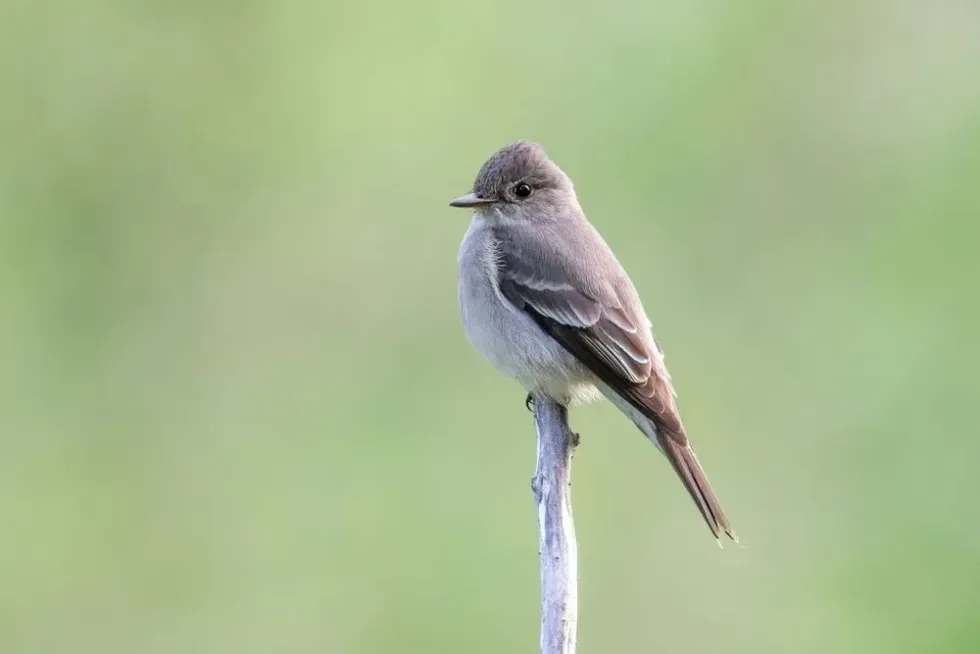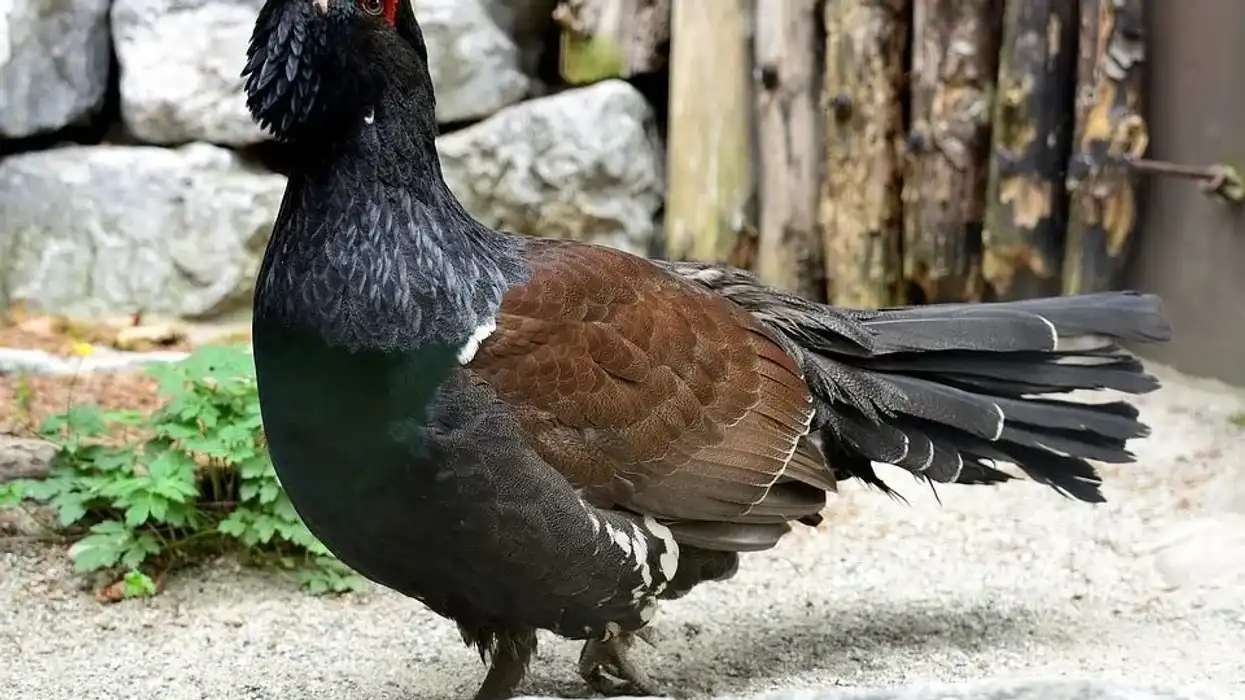There are a total of eight species of birds in the Pewee family. Western wood pewee birds are one among the same family. Their common name is western wood pewee and their scientific name is Contopus sordidulus. They are named after their sound.
Pewee has also often spelled 'peewee'. There exist three types of pewee birds of North America native to the region. The eastern and western are seen in the largest range.
The western wood pewee has a blurry 'peeurrr' sound while the eastern wood pewee has a clear 'pee-oo-wee' sound. Such minor differences exist among all species of the Pewee family.
In this article, we will take a look at some fun and interesting facts about the Western wood pewee. These birds are seen primarily in western North America and are migratory birds.
They migrate from the northern areas to southern areas in the fall and by winter they travel further south. If you like this article, then you should also visit Razorbill and Sarus Crane facts.
Western Wood Pewee Interesting Facts
What type of animal is western wood pewee?
The Western wood pewee (Contopus sordidulus) is a type of birds animal and belongs to the Animalia kingdom.
What class of animal does western wood pewee belong to?
The Western wood pewee (Contopus sordidulus) is a type of bird that belongs to the Aves class of species and the Tyrannidae family.
How many western wood pewees are there in the world?
The exact number of pewee birds in the world is not known however, there are a total of eight species of birds in the Pewee family.
Where does western wood pewee live?
Tyrant flycatchers prefer to stay in dry habitat environments. They exist in habitats like open woodlands, woodland edges, streams with large trees, and also canopy forests. They are seen in western North America, northwestern Minnesota, east-central Alaska as well as southern Baja, New York, California, Arizona, and Washington.
They are migratory birds and travel from the north in the fall to down south. During winter they travel from southern regions to further southern regions like Panama. They spend winters in the tropics.
What is a western wood pewee's habitat?
The Western wood pewee lives in the woods including evergreen forests, coniferous forests, woodlands, streams with large trees, and also canopy forests. These bird species are also seen in agricultural fields, grasslands, and thickets.
Who do western wood pewees live with?
Western wood pewees are solitary birds however while mating and migrating they often travel in a flock. Tyrant flycatchers are small to medium in size and are territorial of their areas and live in forests near streams with large trees, open understories, and standing dead trees. Oak forests are examples of suitable nesting habitats for this species.
How long does western wood pewee live?
Western wood pewees live a total of seven years. The oldest recorded western wood pewee was eight years one month old when she was recaptured and rereleased during banding operations.
How do they reproduce?
Western wood pewees' breeding season begins in May to June. The adult male sings to attract possible mates as well as to defend their nesting territory.
These nests are cup-shaped plant fibers and placed on horizontal tree branches in the forest built using grasses and other plant fibers bound with spiderwebs. Males then take over woodland territories and then the male and female mate. They are seasonally monogamous.
Post mating the female lays two to four eggs. The incubation period lasts 12 days. The young chick leaves its nest once they start fledging and are independent to search for the food itself.
The young are fed insects primarily by both parents and females spend more time in the nest specifically during the initial few days. Adults have buffy wing bars and juveniles are similar to adults.
What is their conservation status?
The western wood pewee is considered a Least Concern species by the International Union For Conservation Of Nature (IUCN).
Western Wood Pewee Fun Facts
What do western wood pewees look like?
The olive-sided flycatcher is often confused with the eastern phoebe or the willow flycatcher as well however, they are different species of birds. Adults are gray olive on their upper parts and have light underparts with olive on their breasts.
Their head has darker shades as compared to the rest of their body and they have a dark bill. The throats have a whitish color.
The medium-sized grayish flycatcher has a peaked crown and two wing bars and a dark bill with yellow at the base of the lower mandible. They weigh 0.4-0.5 oz (11-14 g) and their length is wingspan is 10.2 in (26 cm).
They have long wings which distinguish them from similar species. They have two wing bars and it is buff gray in color.

How cute are they?
They are extremely cute to look at and these songbirds have a positive impact on birdwatchers. They also help regulate insect populations and are small in size. There exists detailed information about these species of birds on the National Geographic website.
How do they communicate?
Western wood pewees' best mode of identification is their range and voice. They are considered true songbirds. They also have an agitated call that is a harsh, slightly descending 'peeer' sound. Their song consists of three rapid descending 'tswee tee teet'. They have various other forms of communication including acoustic, chemical, body language, visual and tactile.
How big is western wood pewee?
The western wood pewee is 5.5-6.3 in (14-16 cm) in length which is 10 times bigger than the smallest bird in the world the bee hummingbird which is 2.4 in (5-6.1 cm).
How fast can a western wood pewee fly?
Western wood pewees have relatively good speed. They fly at the greatest speed when they are about to catch prey which they do in the air in most instances. They are migratory birds and can traverse long distances easily.
How much does western wood pewee weigh?
These birds weigh 0.4-0.5 oz (11-14 g). This depends on various factors like their diet and environment however, given that they are migratory birds they don't gain a lot of weight. The heaviest flying bird in the world is the kori bustard native to South Africa. They are often named the largest flying bird.
What are the male and female names of the species?
The male and female of the species are not addressed differently. Adult males and females appear more or less the same however they differ in reproductive functions.
What would you call a baby western wood pewee?
The baby western wood pewee is referred to as nestling when they are small. They can also be referred to as juveniles. The young are completely dependent on their parents in the initial few weeks for food and shelter and once they develop feathers and can fly they leave their nests.
What do they eat?
Typically they are seen on a high perch occasionally sallying out to snatch an insect which they primarily feed on. Insects include flies, moths, wasps, beetles, and ants.
They do most foraging by watching from an exposed perch within the shady middle or lower level of a tree. They usually grab their prey in mid-air unlike other species of birds and then return to the perch.
If they are not able to eat it immediately, they grab it and return to the same or nearby perch to eat them.
Are they dangerous?
These birds are not dangerous to humans. Predators who attack these birds also often stay near the perch. Their instant response to any form of danger is their flight instinct. They are territorial beings and tend to make loud noises if troubled.
Would they make a good pet?
They are innately wild birds hence they thrive best in their natural environment i.e. in the wild. Other species of birds like parrots are more accommodative towards being adopted as pets.
Did you know...
There is an application called Merlin which you can install on your phone and it helps you identify which species of bird you just saw. It also saves memories. The only requirements are to take a picture of the species and fill out some basic questions.
The scientific name Contopus sordidulus comes from the Greek word 'kontos' which means short and 'pous' which means foot. Sordidulus means unkempt or dirty which is a reference to the color of the bird being dusky brown.
What does western wood pewee sound like?
The western pewee voice sounds like its name suggests 'pewee'. They communicate using both songs as well as calls. Songs are usually to attract possible mates as well as protect their nesting areas and calls are for other purposes. They also make use of acoustic, chemical, body language, visual, and tactile means to communicate.
Are western wood pewees endemic?
Western wood pewees are endemic to western parts of North America however they are migratory birds and travel south as per the changes in climatic conditions. The exact places where they travel during winter are still not properly evaluated however in the fall they travel from north to south.
They were initially grouped with the eastern wood pewee however they were separated into different categories later on.
If you live in a region native to these bird species keep a lookout to spot these species if you can. If you don't then you could always read more information about them online or in other book resources.
Here at Kidadl, we have carefully created lots of interesting family-friendly animal facts for everyone to discover! Learn more about some other birds from our saker falcon fun facts or black tern interesting facts.
You can even occupy yourself at home by coloring in one of our free printable Eastern wood pewee coloring pages.









